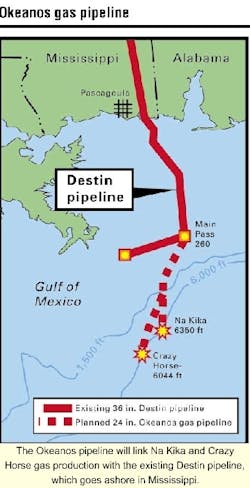GULF OF MEXICO: First ultra-deepwater pipeline to tap Na Kika, Crazy Horse gas
A $150 million pipeline will bring 1,000 MMcf/d of natural gas from the ultra-deepwater Na Kika and Crazy Horse fields to serve a gas-hungry US market. The new production should modestly help reduce the impact of weakening gas deliverability from wells on the continental shelf.
In mid-May, BP and Shell announced construction plans for the Okeanos pipeline project. The 100-mile pipeline will be the first Gulf of Mexico gas pipeline built to operate in water depths exceeding 6,000 ft, making it the deepest gas gathering system in the Gulf of Mexico.
The Okeanos Gas Gathering Company, which will manage the line, will be owned 2/3 by BP and 1/3 by Shell Gas Transmission, with BP serving as the operator.
Okeanos will connect ultra-deepwater developments with the Destin Pipeline, which comes onshore in Mississippi and interconnects with five interstate pipelines that serve growing natural gas markets throughout the entire eastern United States.
Gas gathered through the Okeanos pipeline and transported by Destin will be processed at the BP-operated Pascagoula Gas Processing Plant. This pipeline is the first of the Mardi Gras Trans-portation System projects that will serve new BP developments in the deepwater Gulf of Mexico.
Construction program
The Okeanos gas pipeline will be built in two phases, beginning in 2002. Shell Gas Transmis-sion will serve as construction manager for the first segment, which will consist of a 74-mile, 24-in. diameter pipeline to gather gas produced from the Shell and BP Na Kika project.
Na Kika is under development by Shell about 150 miles southeast of New Orleans. The project consists of the subsea development of six individual fields tied back to the Gulf of Mexico's deepest permanently moored semisubmersible development and production system. The unit will operate in 6,350 ft water depth.
Construction of the first segment of the Okeanos pipeline will be completed in time for the 2003 startup of the Na Kika fields.
The second phase, for which BP will act as construction manager, will consist of a 26-mile segment to connect the BP and Exxon Crazy Horse field to the Okeanos gas pipeline near Na Kika.
Construction on this segment will be completed in 2005 in time for the start-up of the Crazy Horse field. The Crazy Horse field is the largest oil and gas discovery in the Gulf of Mexico and will be operated by BP.
Crazy Horse oil
In 2000, BP announced the Mardi Gras pipeline would tap the oil reserves on the Crazy Horse prospect in 6,000 ft water depths. Crazy Horse has reserves estimated at 1 billion bbl of oil. The Mardi Gras pipeline is slated to move 1 million b/d from Crazy Horse, Atlantis, Mad Dog, and Holstein.
The latter three are located southwest of Crazy Horse (due south of New Orleans) in the southern Green Canyon area, and will be accessed by a pipeline separate from Crazy Horse. The two segments will join near the shoreline. BP is managing the project.
Intec Engineering is engineering the deep-water portions of the Mardi Gras pipeline, in addition to some of the steel catenary risers on the field. Some years ago, Intec participated in early design of the Oman-to-India gas pipeline, which was slated to transit 11,000 ft water depths.

